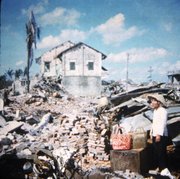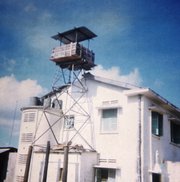In November, 1971, Captain Denis Gulakowski began what he thought would be a relatively “safe” tour of duty in Vietnam.
The Cold War military conflict had escalated steadily since 1955, and reached a high of 500,000 troops in 1967. By late 1971, the number of American troops in-country had been greatly reduced as President Richard Nixon implemented his “Vietnamization” program to extract the United States from the war.
Nixon’s aim, according to historians, was to negotiate a settlement that would allow the half million U.S. troops in Vietnam to be withdrawn, while still allowing South Vietnam to survive.
The young West Point graduate, 24 years old and newly married, was one of two American military advisors assigned to work with a group of Vietnamese soldiers at a small compound 50 miles southeast of Saigon, near the South China Sea.
In March, 1972, the North Vietnamese launched a major offensive, known as the Easter Offensive.
Easter Offensive Remembered
“I moved in the direction of the enemy and drew their fire, which identified the enemy machine gun location [giving the gunships their target.] … To borrow an old combat expression, ‘the enemy was in the wire.’”
—Retired Army Lt. Col. Denis Gulakowski
U.S. intelligence expected some sort of attack to improve the negotiating position of the North Vietnamese during peace talks being conducted with U.S. Secretary of State Henry Kissinger. But the size and ferocity of the attack took the U.S. by surprise.
In March, 1972, the North Vietnamese Army struck on three fronts simultaneously. More than 20,000 North Vietnamese troops crossed the DMZ (demilitarized zone) forcing the South Vietnamese units into a retreat and throwing the Southern defense into chaos.
“The NVA’s strategy was to occupy as much territory in South Vietnam as possible before the Peace Talks concluded. The theory being that when the cease-fire was signed and all military activity was frozen, whoever owned the most terrain would keep that terrain as part of the final political settlement,” Gulakowski said.
THE SITUATION changed suddenly for Gulakowski.
“Up until this time, the province we were in was considered relatively safe,” said Gulakowski. “And that was why it became a very, very big target, because if the enemy was successful, it would show that the Vietnamese program was not working, and would embarrass both the U.S. and South Vietnamese governments.”
Over several weeks, Gulakowski and his colleagues received reports of North Vietnamese forces infiltrating villages near his post. Soon the enemy had surrounded the nearby South Vietnamese National Police Headquarters, as well as Gulakowski’s compound.
Anticipating an attack, the Americans developed an escape plan, “which primarily consisted of two light-skinned, blue-eyed Americans dressing up in black Vietnamese pajamas wearing conical hats and sneaking out of the compound,” Gulakowski said.
But ultimately Gulakowski was drawn into direct confrontation with the enemy, rather than escape.
“It was daylight and we were moving from the district headquarters toward the National Police Headquarters, which was surrounded by the NVA, in an attempt to rescue the police force,” he said.
Gulakowski’s team was pinned down by heavy automatic weapons fire.
“I immediately called for helicopter gunships, and two AH1G cobras were dispatched” from a nearby base, recalled Gulakowski.
The helicopter pilots initially had trouble locating the source of the enemy fire.
“I moved in the direction of the enemy and drew their fire, which identified the enemy machine gun location,” said Gulakowski, giving the gunships their target.
Shortly thereafter, Gulakowski and his comrades received information that the North Vietnamese were moving into position to attack their compound.
They called in a reconnaissance aircraft, which was able to see that several hundred enemy troops had infiltrated the barbed wire and concertina wire obstacles at the southern end of their compound, and were lying in wait to attack after dark, said Gulakowski.
“To borrow an old combat expression ‘the enemy was in the wire’ literally,” Gulakowski said.
The Americans called for an airstrike against the North Vietnamese, although the enemy was in what Gulakowski called “Danger Close” position, requiring accurate fire from friendly aircraft to avoid injuring the American and South Vietnamese troops.
“I had climbed an observation tower to better direct the airstrike,” recalled Gulakowski. “When the enemy saw me climb the tower, they fired mortar rounds at the tower. Fortunately, they were unsuccessful, although it was somewhat unnerving sitting there with mortar rounds exploding all around.”
“I really didn't have time to be frightened,” Gulakowski said. “Although, obviously, in the back of my mind the self-survival instinct was in effect.”
THE AIRSTRIKE was successful. The North Vietnamese drew heavy casualties and withdrew from Gulakowski’s compound.
The Easter Offensive, which lasted until October, 1972, was a disappointment to the North Vietnamese, and peace talks accelerated after it was called off.
For its actions in disrupting the Easter Offensive in their part of the country, Gulakowski’s unit, Advisory Team 89, received a Meritorious Unit Commendation from the U.S., the second highest unit award.
The commendation is “awarded to units for exceptionally meritorious conduct … against an armed enemy. … The unit must display such outstanding devotion and superior performance of exceptionally difficult tasks as to set it apart and above other units with similar missions” according to the Code of Federal Regulations.
And several of the team members were awarded the Silver Star, including Gulakowski, the third highest U.S. individual valor award for “conspicuous gallantry in action.” Additionally, the team was awarded the Vietnam Presidential Unit Citation, and some members were awarded the Vietnamese Medal of Honor by the South Vietnamese leadership.
“And, most importantly,” said Gulakowski, “we all got to come home in one piece.”




